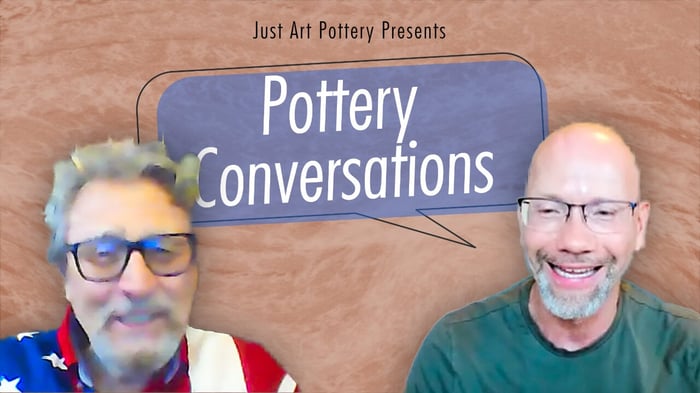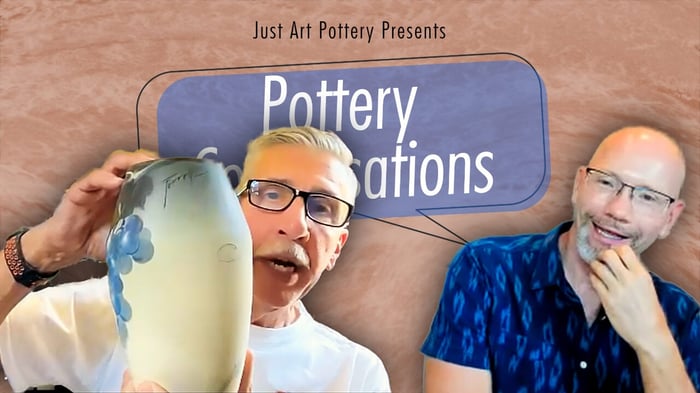Welcome to Pottery Conversations hosted by JustArtPottery.com Owner, Greg Myroth, where we delve into the world of vintage and collectible art pottery! From renowned experts and authors to passionate collectors and seasoned dealers, we'll bring you insightful conversations that celebrate the beauty and craftsmanship of American art pottery and European ceramics. Whether you're a seasoned collector or just beginning your journey into the world of art pottery, there's something for everyone on Pottery Conversations. Subscribe and stay tuned for uploads and highlights from each episode.
Rookwood Pottery and the Joy of Collecting with Mark Latta - Pottery Conversations - Episode 4
In this episode of Pottery Conversations, we say hello to a new guest: Mark Latta! Mark shares how he and his wife Marie got started collecting art pottery over 35 years ago with a chance purchase at an auction that led to collecting the full Roseville lines. They reminisce about the challenges of finding pieces in the pre-internet era and attending auctions and markets together.
They provide insights on collecting rare and valuable pottery like Rookwood, discussing how timing and rarity can greatly impact prices, and the importance of understanding unique features like glazes. Mark discusses how damage affects the value of art pottery and shares advice for new collectors.
They also share their love for Rookwood pottery while encouraging buyers to look beyond the famous makers and appreciate the artistry and quality of pieces over the maker’s mark. Listen for this and more lessons Mark has learned along the way!
0:00 - Start
02:23 - How Did You Start Collecting?
07:38 - Playing The Waiting Game For Pieces
13:04 - Mark Latta's Advice For New Collectors
22:53 - What Are Some Undervalued Makers?
31:05 - What Are Your Thoughts On Condition?
38:09 - How Does Damage Affect Value?
41:16 - Tips For Identifying Good, Better, And Best Rookwood
50:27 - Upcoming Pottery Events
54:10 - Additional Words of Wisdom
01:05:20 - Outro
SUBSCRIBE for more Pottery Conversations episodes and highlights: https://www.youtube.com/@justartpotte...

More Information:
Rookwood America's Contribution to the Fine Arts
Marie and Mark Latta have been avid collectors of American Art Pottery for over 30 years. Their extensive collection features rare and experimental pieces, particularly iconic shapes and glazes from various potteries, with a special focus on Rookwood. Their deep knowledge of ceramics and the prolific production period is matched only by their generosity in sharing their collection and expertise. They have curated nearly 100 pieces from their Rookwood collection, showcasing different glazes and decorative techniques to highlight the creativity, skill, and innovation of the American ceramic industry.
Rookwood Pottery 1991 and 1992: The Glorious Gamble and the Glover Collection
Two significant events in 1991 and 1992 profoundly influenced the Rookwood Pottery collecting market. In June 1991, Cincinnati Art Galleries auctioned the extensive Glover Collection, featuring over 1,600 pieces of Rookwood Pottery. The following year, the Cincinnati Art Museum unveiled the Glorious Gamble exhibition, showcasing 100 of Rookwood’s finest works. Riley Humler, who was involved in both events, will recount the history leading up to these milestones and their subsequent impact on the market.
Minnesota Art Pottery Association
American Art Pottery Association
Summary of Episode 4:
Greg Myroth interviews long-time art pottery collector Mark Latta, who shares how he and his wife Marie got started collecting pottery over 35 years ago. Mark explains that after seeing Majolica pottery featured in a magazine, they began seeking out pieces at local antique shops, which quickly turned into a passion. Mark credits Marie for sparking his interest in collecting and guiding him to expand his knowledge and appreciation for art pottery over the years. Specifically, they share their experiences of getting into collecting Roseville pottery, starting with a chance purchase at a local auction. They then discovered the Huxford book, which inspired them to start collecting the full range of Roseville lines.
The discussion covers the challenges of finding Roseville pieces in the pre-internet era, reminiscing about attending auctions and markets together, and the dynamics of the collector market, where pieces can cycle back to the same collectors over time. The speakers discuss the nuances of collecting rare and valuable pottery, using their experience with Rookwood pottery as an example and highlighting how the timing of when a piece comes up for auction can greatly impact its price. They also emphasize the importance of understanding the rarity and unique features, like glaze colors, that can drastically affect the value of a piece. For example, we’ll discuss the appeal of matte green glazes and the influence of Van Briggle on the development of matte glazes in American potteries like Rookwood, Weller, and Roseville.
Overall, the conversation provides valuable insights for new collectors on the dynamics of the pottery market and how to approach building a collection. Mark also discusses the challenges facing new pottery collectors in the current market. The veteran collector, who has been in the hobby for nearly 30 years, offers advice to the newer collector, the key points being:
- · It’s important to find reputable dealers and do research, such as reading books on pottery. This can help new collectors develop their own taste and not just rely on others' opinions.
- · Attending shows and making connections with dealers is still valuable, even though there are fewer shows these days.
- · The most important thing is to collect what you are truly passionate about, whether it's an inexpensive piece or a rare, high-value item.
Developing your own collecting interests is more rewarding than just chasing the most expensive items. The speakers discuss their passion for collecting pottery, particularly Rookwood and Pigeon Forge pieces. They highlight the value of books, such as those by Frank Norman on Weller, which provide valuable information and insights into the history and stories behind different pottery makers.
The speakers also share their own collecting experiences, including finding affordable alternatives to high-priced Rookwood items, and the joy of acquiring unique pieces. We discuss the undervalued nature of certain art pottery makers, particularly Weller. They note that while Weller's quality control may not have been as consistent as Rookwood's, the company employed talented artists who produced exceptional work. Collectors should look beyond just the maker's mark and instead focus on the quality and artistry of the individual pieces.
They also mention other potentially undervalued makers like Owens and emphasize the importance of trusting one's own judgment when evaluating pottery, rather than being swayed solely by a maker's reputation. Latta’s passion for collecting has taught him the importance of learning to identify quality craftsmanship and glaze work, rather than just focusing on the brand name.
The speakers also recommend exploring lesser-known pottery collections, such as Frankcoma, Nicodemus, and Haeger, as they can offer unique and affordable entry points for new collectors. There is joy in discovering and learning about these niche pottery makers, which can be just as rewarding as collecting the more well-known brands.
Understanding condition when evaluating and purchasing pottery is important, as damaged or repaired pieces can significantly impact the value, no matter how small. Repairs can even be used to cover up underlying issues. Note that drill holes, however, were a common modification from the early 1900s when pots were converted into lamps, are actually part of the history of the piece and should be left as is.
The speakers caution against being taken advantage of by sellers who do not disclose the true condition of an item and encourage doing thorough research to identify fakes and reproductions and use caution if buying something repaired. Overall, the conversation highlights the nuances of the pottery collecting market and the need for collectors to be informed and discerning when making purchases. It’s a good idea to buy unrepaired, original condition pieces whenever possible, as this preserves the integrity and authenticity of the collection.
For mass-produced pottery, a minor flaw like a base chip or hairline can reduce the value by around 50%, while for more rare and valuable pieces, the reduction is less significant. The key is to buy from knowledgeable sellers, inspect the item thoroughly, and let the condition inform the valuation.
Collector Mark Latta shares his expertise on evaluating and acquiring quality Rookwood pottery. He highlights the value of early 20th century Rookwood production pieces, particularly those from 1900-1916 when the company used a higher-fired porcelain clay and developed richer, more interesting glazes. Latta praises the work of designer William Hentschel, whose carved designs and use of Rookwood's "Ambroso" glaze created stunning, collectible pieces from the 1910s.
He advises focusing on Rookwood's standard brown glazes, as well as those featuring animals and Native American motifs, as they are often undervalued but of excellent quality. We discuss the history and evolution of Rookwood pottery, a renowned American ceramics manufacturer, and focus on the period around 1917, when Rookwood made significant changes to its clay and glaze formulas, leading to the production of high-quality, uncrazed pottery with exceptional decorative work by their skilled artists.
We highlight specific Rookwood pieces from the 1920s as some of the best the company ever produced and mention their involvement in two museum exhibitions featuring Rookwood and other American ceramics. Overall, the conversation provides insights into the technical and artistic advancements at Rookwood during a pivotal time in the company's history. Mark and Greg discuss an upcoming event where Riley will give a presentation on the Glorious Gamble and Glover Collection, which was a turning point for collecting Rookwood pottery in the United States.
Mark encourages listeners to attend the event in Ames, Iowa on June 2nd, as it's a great opportunity to see amazing pottery in person. Mark also shares his experience with the Iowa Art Pottery Association, a group he helped start that meets regularly to share finds, swap items, and enjoy each other's company. He suggests that others consider starting similar local groups to connect with fellow collectors and enthusiasts.
The speakers discuss the importance of engaging with pottery collector communities, such as attending shows and events, to enhance one's knowledge and appreciation of art pottery. They emphasize the value of networking, learning from others, and being open to new discoveries. The speakers also highlight the benefits of buying and selling pottery, not just for financial gain, but for the opportunity to learn about trends and make better collecting decisions.
Overall, the conversation underscores the joy and enrichment that can come from actively participating in the art pottery community and showcases the speakers' deep appreciation for the art and craft of pottery collecting.











